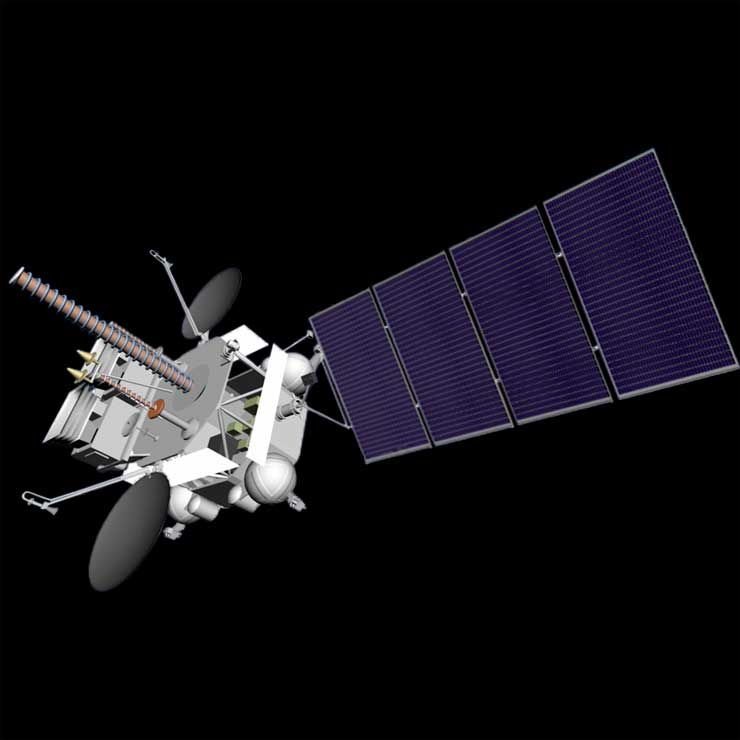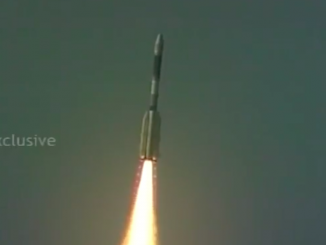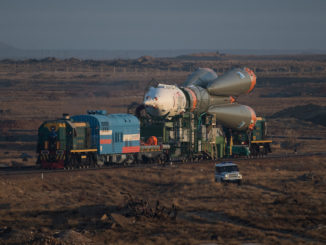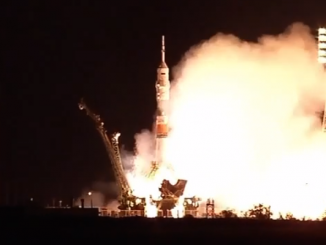A weather satellite to help civilian and military forecasters track storm systems over Russia’s vast territory launched from the Baikonur Cosmodrome on Friday aboard a Ukrainian-built Zenit rocket, perhaps on its final flight as Russian-Ukrainian relations sour and demand wanes for the 1980s-era launcher.
The Elektro-L 2 weather satellite, enclosed inside the Zenit rocket’s nose shroud, is beginning a 10-year mission to collect near-realtime images of weather systems from Europe to the Asia-Pacific, joining an international fleet of geostationary weather satellites owned by the United States, Europe, India, China and Japan.
The nearly 20-story rocket, running on an automatic countdown sequencer, was fueled with kerosene and liquid oxygen propellants and readied for liftoff from Site 45 at the Baikonur Cosmodrome in Kazakhstan.
In the final seconds of the countdown, the Zenit’s first stage RD-171 engine fired up with a flash of green-orange flame, powering up to full thrust and powering the rocket off the launch pad at 1345:33 GMT (8:45:33 a.m. EST), or 7:45 p.m. local time in Kazakhstan.
Status reports broadcast on an Internet video stream of the launch indicated the early phases of the launch went according to plan, with separation of the Zenit rocket’s first stage and payload fairing before arriving in a preliminary parking orbit about eight-and-a-half minutes after liftoff.
The Elektro-L 2 weather observatory flew atop a the Zenit 3SLBF, or Zenit 3F, version of the rocket with a Russian-made Fregat SB upper stage designed for multiple engine firings to put payloads into orbit thousands of miles above Earth.
The flight plan Friday called for three burns of the Fregat main engine to boost the weather satellite to progressively higher orbits, eventually reaching a circular geostationary orbit nearly 36,000 kilometers (22,300 miles) over the equator.
Separation of the Elektro-L 2 weather satellite was scheduled for 2243 GMT (5:43 p.m. EST) Friday, according to a timeline released by Roscosmos, the Russian space agency.
The satellite, with a launch mass of more than 1.8 metric tons (about 4,000 pounds), was then expected to unfurl its power-generating solar panels.
A press release from Roscosmos late Friday said the satellite was placed into its targeted orbit, and ground teams took control of the spacecraft as planned.
Elektro-L 2 is heading for an operating post at 77.8 degrees east longitude, where its weather sensors will track storms with an image refresh rate of about 30 minutes. More frequent images could come down from the satellite during certain times, Roscosmos said.

Its launch comes nearly five years after a Zenit rocket shot the Elektro-L 1 satellite into orbit, and the second member of the series incorporates upgrades to avoid problems that plagued the first craft.
The satellite also carries instruments to monitor space weather and a search-and-rescue communications payload, according to information published by Roscosmos.
One more flight-ready Zenit rocket is built and in storage, assigned to launch Russia’s Spektr RG space telescope in 2017, but the official Tass news agency reported in November the warranty on the rocket has expired. Some components for other Zenit boosters have been fabricated at Yuzhmash, the rocket’s builder in Dnipropetrovsk, Ukraine.
Friday’s launch was the 83rd flight of a Zenit rocket since 1985, and its first mission since May 2014.
The primary user of Zenit rockets since 2000 has been Sea Launch, a commercial launch firm with an operations base in Southern California and corporate headquarters in Switzerland.
Sea Launch flew Zenit rockets from a converted North Sea oil drilling platform from a point along the equator in the Pacific Ocean, a good location for launching heavy commercial satellites that could use a velocity boost from the faster speed of Earth’s rotation at low latitudes.
But the company suffered an explosive launch failure in 2007 that destroyed a communications spacecraft and damaged its ocean-based launch platform, then Sea Launch filed for bankruptcy and reorganized under majority Russian ownership.
Boeing owned the biggest slice of Sea Launch before the reorganization, but Russia’s Energia aerospace contractor took control of 95 percent of the company after the bankruptcy.
Another Zenit rocket crashed moments after liftoff in 2013 with an Intelsat communications satellite.
Sea Launch’s last mission in 2014 successfully sent up a Eutelsat telecom spacecraft.
Without any firm commercial orders in its backlog, Sea Launch suspended flight operations at its home port in Long Beach, California, after the Eutelsat mission and began selling off non-essential assets this year.
The Zenit rocket’s market in Russia has also dried up, partially due to Russian involvement in the conflict in Ukraine.
The situation means Friday’s Zenit rocket launch may be the last flight of the vehicle, which began development in the 1970s as the Soviet Union eyed modernized rockets to replace aging Soyuz and Proton designs rooted in the 1950s and 1960s.
But the older rockets will outlive the Zenit.
The RD-171 main engine on the Zenit booster produces 1.6 million pounds of thrust at sea level, and its builder — NPO Energomash 0f Moscow — bills it as the world’s most powerful operational liquid-fueled rocket engine. Derived from the RD-170 powerplant built for the strap-on boosters for Russia’s Buran space shuttle, the four-nozzle engine has smaller dual-nozzle and single-nozzle cousins that have found success in the export market.
The RD-180 engine is currently flying on United Launch Alliance’s Atlas 5 rocket, and Russia’s new-generation Angara launcher family uses RD-191 engines. Another member of the RD-171 family tree, the RD-193, flew on South Korea’s Naro-1 rocket three times from 2009 through 2013.
Two RD-181 engines, another variant of the Zenit main engine, will power Orbital ATK’s Antares space station cargo rocket when it returns to flight in 2016. Orbital ATK’s Antares first stage is also manufactured by Yuzhmash, the same contractor responsible for Zenit production.
Email the author.
Follow Stephen Clark on Twitter: @StephenClark1.



